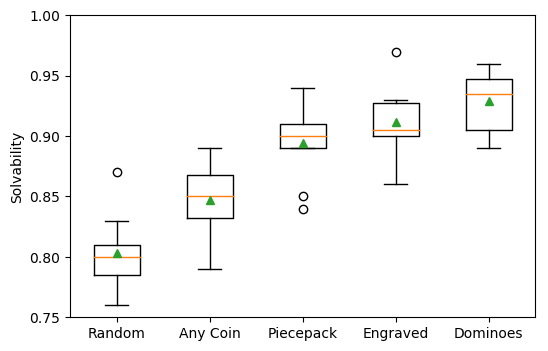I spent most of September thinking about Fujisan. As I mentioned in an earlier post on board game designs, my friend James was interested in the percentage of random board setups that were solvable in his game, and I built a program to simulate random setups and solve them. The results looked promising, so I wrote up a few other setup methods for comparison, finally giving us the following graph, which shows the solvability of each method.

The percentages were high! The next question was why? As we dove into these simulations, it became clear to us that we’d found a nice case study for examining Procedural Content Generation within a physical board game. So, we scoured the literature for related works, generated more data across different metrics, and wrote and wrote and wrote to understand what we had learned through this process.
Finally, we went in search of a publication venue, and finding that Game & Puzzle Design Journal was no longer on a regular publication schedule, we tuned our article to the newly-rechristened IEEE Transactions on Games. We’re hoping to hear back in a few months, in the meantime, we’ve posted a preprint on arXiv with all the details, and would love to hear your feedback. Here’s the abstract of our submission:
Challenges for physical solitaire puzzle games are typically designed in advance by humans and limited in number. Alternately, some games incorporate stochastic setup rules, where the human solver randomly sets up the game board before solving the challenge, which can greatly increase the number of possible challenges. However, these setup rules can often generate unsolvable or uninteresting challenges. To better understand these setup processes, we apply a taxonomy for procedural content generation algorithms to solitaire puzzle games. In particular, for the game Fujisan, we examine how different stochastic challenge generation algorithms attempt to minimize undesirable challenges, and we report their affect on ease of physical setup, challenge solvability, and challenge difficulty. We find that algorithms can be simple for the solver yet generate solvable and difficult challenges, by constraining randomness through embedding sub-elements of the puzzle mechanics into the physical pieces of the game.
I also worked up a set of Fujisan Powerpoint Slides and plan to give a talk at Hendrix sometime in the next month. I’d hoped to use Google Slides, but couldn’t find a way to make objects move around the screen. In the end, I’m quite happy with the animation of Fujisan gameplay I could make in Powerpoint:
